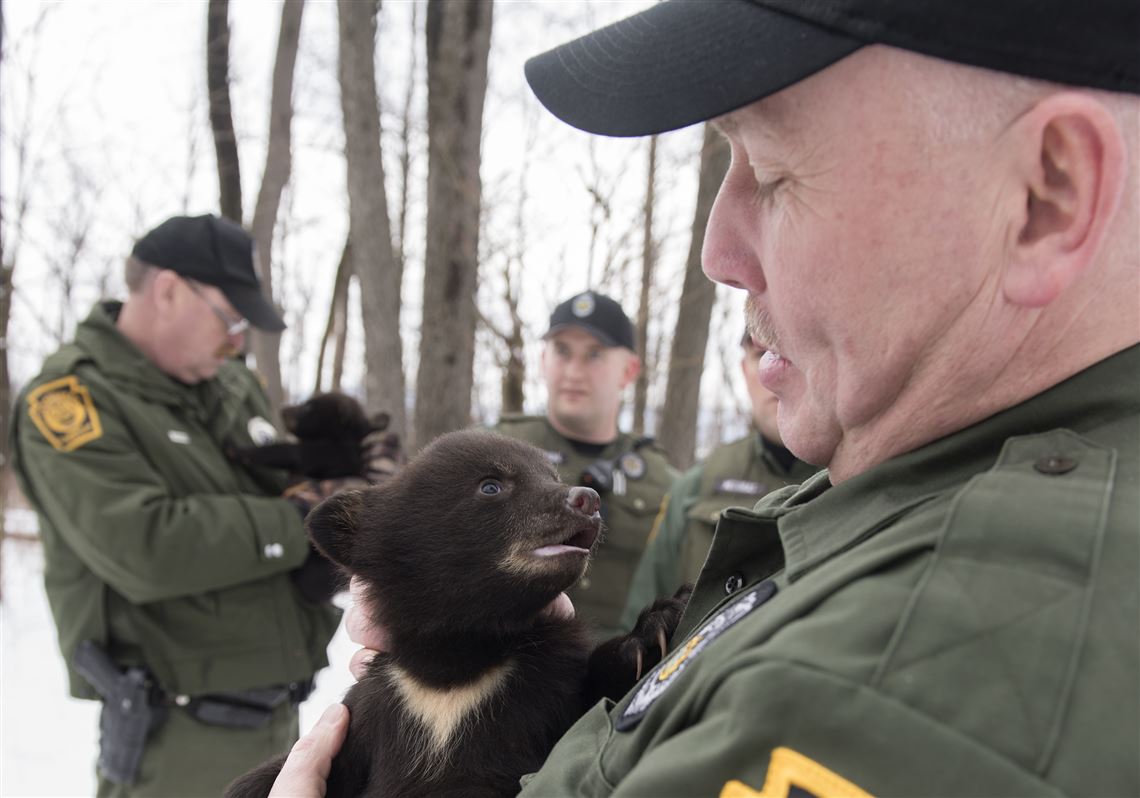Late last year, a she-bear made her den in remote woods near the Eastern Continental Divide in Cambria County. Four or five trees that had fallen into each other created a shelter, the kind of spot children would fashion into a fort.
She piled twigs and leaves into a bed, and that’s where she had three cubs in mid-January. Under a leaden sky, she kept them warm and they fed from her as their hair grew and their eyes began to see.
Eight weeks later, on the first day of spring, a convoy of Pennsylvania Game Commission vehicles arrived in a clearing about 200 snow-covered, tree-littered, brambly paces from the den. The officers knew where she was because she wore a radio transmitter collar.
Bear biologist Mark Ternent, veterinarian Justin Brown and three officers, all in olive drab, toting olive drab packs, set off into the woods like a line of soldiers.
Every March, in three study areas of the state, crews visit dens that the commission has identified, thanks to bears that send signals. They give each new cub numbered ear tags and assess the health of the cubs and the mother.
Fourteen cubs were identified in four active dens this year in the southwest study area, which makes up Cambria, Somerset and Westmoreland counties. The other two study areas are northeastern and northcentral.
Mr. Ternent said 65 she-bears are currently wearing transmitters in the state. Among the commission’s data are tag numbers, den locations, blood samples and details of bear removals, such as from underneath people’s porches.
Monitoring begins
The practice of monitoring bears began in the mid 1980s after the population had dropped to about 5,000 in the 1970s. The game commission at the time worried those numbers could not be sustained with annual bear hunting.
According to a 10-year plan that Mr. Ternent prepared in 2006, bear hunting between 1915 and 1975 remained steady, around 500 or fewer a year taken. In the mid 1970s, the numbers began moving upward. In 1977 and 1978, the game commission banned hunting altogether, he wrote. That helped numbers begin to rise. Also, bears were moved around so their populations could grow in peripheral regions and hunting licenses were limited in those areas.
Pennsylvania now has about 21,000 black bears, “which is probably as high as it’s ever been,” said Seth Mesoras, wildlife conservation officer for the Cambria district. The population allowed for more hunting, and in recent years, the annual total taken ranges from more than 2,000 to around 3,000.
During hunting season, hunters are required to take their kill to checkpoints. If the animals had been tagged, the tag numbers are placed in the data. There are different days for different weapons permitted for killing bears. The commission holds each license holder to a one-bear limit per category — whether bow and arrow, rifle or muzzle loader -— per license year.
“We could sustain more in the wild, but not with the social ramifications” in encounters with people, said Tom Fazi, information and education supervisor. “We don’t want bears in Allegheny County.”
They are there, though, because bears tend to ramble.
A 300-pound male was reported in Wexford two weeks ago eating bird seed, he said. A 15-month-old cub that was tagged in Cambria County walked into a Sears store in Frazer in 2012. Both were tranquilized, hauled away and relocated.
When conservation officers find orphan cubs, they apportion them to dens where a female may have just one or two.
“With their maternal instinct so strong, it usually works,” Mr. Fazi said.
The cubs have roughly 17 months with their mother, then it’s another breeding season. Male bears might kill young cubs if they were still hanging with the mother past that point, so she shoos them off to fend for themselves. Female bears usually top out at 250 pounds, males at 500.
Much of a wildlife officer’s work in the spring is chasing complaints of what they call “nuisance bears” — those that encounter people or ransack their garbage, Mr. Mesoras said.
“But when things start growing, especially berries,” he said, “they rely more on what’s in the woods.”
The crew’s approach
High up in Cambria County on a cold gray day in the 40s, the five men in olive drab approached the den where the female was awake. Hibernating bears don’t sleep all winter, as is commonly believed. They are alert much of the time and even leave their dens, usually without going far.
Mr. Ternent described the crew’s approach: “As I pushed and pulled my way through the [blackberry] briars, she kept looking around, and looking down at the cubs who were sitting at her feet. She was sitting on her rump. She was acting relatively nervous, and I honestly expected her to jump out of the den. I darted her in the right shoulder from about 12-15 feet away. She started lowering her head around four minutes after darting, and was safely laying on the ground by seven minutes.”
She lay for about an hour, her open eyes blindfolded to protect them from debris. Her heavy coat rose and fell slowly as Dr. Brown began the medical check-up — palpating her stomach, listening to her heart, drawing blood and checking her teeth.
Wildlife officers removed the three cubs for evaluation and carried them a short distance away, where a dozen civilians, including three children and a few newspaper and television reporters, waited. They had been invited to come along to witness and learn about the process and -- most important -- to hold a bear cub.
The little bears clutched people’s coats with needle claws or hung over arms with splayed feet and shivered. Everyone oohed and cooed quietly, as instructed, so as not to arouse the mother. The two males and one female weighed between five and seven pounds. One boy-cub scraped the air with his claws bared.
Even commission officers smiled like new parents as they held the cubs. Several people kissed the cubs on their heads.
Mr. Fazi said these interactions have never resulted in detrimental effects to the animals.
After photographs were taken, the officers weighed the cubs, putting each one in a bag hung from a scale. Then they stapled metal tags on the cubs’ ears. The tags are floppy, leaving room for the ears to grow. The process is bloodless, but each cub yowled like a cat as the kids gasped and the adults made pity sounds.
Jodi Geibig, who works for a magistrate in Cambria County, was along for the adventure with her husband Terry Geibig, a constable.
“What an incredible experience this has been,” she said. “We were here last year but the bear didn’t have any babies. This was amazing. Most people don’t get a chance to do anything like this.”
As the crowd began retracing bootmarks in the snow back to the clearing, wildlife officers returned the cubs to the den, settling them into the warm crevices of their sleeping mother.
Diana Nelson Jones: djones@post-gazette.com of 412-263-1626.
First Published: March 26, 2017, 4:00 a.m.














